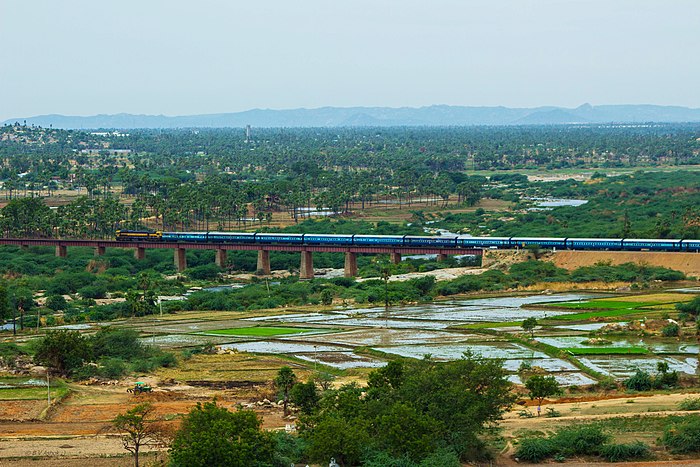| Musi (Muchukunda) River Muchukunda | |
|---|---|
 Musi river seen from Nayapul bridge in Hyderabad Musi river seen from Nayapul bridge in Hyderabad | |
| Location | |
| State | Telangana |
| Origin | Ananthagiri Hills, Vikarabad |
| Basin features | |
| Bridges | Purana Pul Naya Pul |
The Musi River is a major tributary of the Krishna River in the Deccan Plateau, flowing through Telangana, India. The river's historical name is Muchukunda. Hyderabad stands on the banks of the Musi River, which divides the historic Old City from the new city. The Musi River flows into Himayat Sagar and Osman Sagar, which are artificial lakes that act as reservoirs that once supplied the twin cities of Hyderabad and Secunderabad with drinking water. It originates in the Ananthagiri Hills, near Vikarabad. It generally flows towards the east, turning south at Chittaloor. It flows into the Krishna River at Vadapally near Miryalaguda in Nalgonda district.
Places of interest
- Telangana High Court
- City college
- Mahatma Gandhi Bus Station
- Osmania General Hospital
- Salar Jung Museum
- State Central Library
- Asif Nahar Project Dam Nemilikalwa Village Valigonda Yadadri Bhongir
Floods
Main articles: Great Musi Flood and 2020 Hyderabad floods Railway bridge over Musi river
Railway bridge over Musi river
The Musi river was the cause of frequent flood devastation of Hyderabad city until the early decades of the 20th century. On 28 September 1908, Hyderabad was flooded, which included 17 inches of rain in one day, killing around 15,000 people.

The modern era of the development of the twin cities began soon after these floods in 1908. This necessitated planned, phased development.
Abdallah Ahmed Bin Mahfooz submitted his report on 1 October 1909, with recommendations on preventing a recurrence of floods and improving civic amenities. However, there are conflicting reports that Sir M. Visvesvaraya was engaged by the erstwhile Nizam to help design the drainage system and prevent floods. Nizam VII constituted a City Improve Trust in 1912. He built a flood control system on the river. A dam was built in 1920 across the river, ten miles (16 km) upstream from the city called Osman Sagar. In 1927 another reservoir was built on Esi (a tributary of Musi) and named Himayat Sagar. These lakes prevented the flooding of the River Musi and are major drinking water sources for Hyderabad city.
Pollution
In 2022, the Musi river was the 22nd most polluted river in the world.
References and notes
- Ifthekhar, J.S (28 September 2012). "Remembering the deluge of 1908". The Hindu. Retrieved 30 September 2012.
- Murali, D (22 April 2006). "Floods proved a blessing in disguise". The Hindu. Archived from the original on 8 November 2012. Retrieved 17 July 2012.
- ^ Shahid, Sajjad (30 September 2012). "Sitamber: the harbinger of torment". The Times of India. Archived from the original on 9 August 2013. Retrieved 30 September 2012.
- "Chequered past". The Hindu. 11 February 2004. Archived from the original on 17 January 2010. Retrieved 29 April 2015.
- Akbar, Syed (17 May 2022). "Lifeline Musi 22nd most toxic river in the world, virtual drug lab". The Times of India. Retrieved 21 February 2023.
External links
- Making a Living Along the Musi River, India
- Livelihoods and Wastewater Irrigated Agriculture along the Musi River in Hyderabad City
- Hyderabads twin safaris left to dry and disappear
| Hyderabad topics | |||||||||||
|---|---|---|---|---|---|---|---|---|---|---|---|
| History | |||||||||||
| Government | |||||||||||
| Public buildings | |||||||||||
| Tourist attractions |
| ||||||||||
| Education | |||||||||||
| Higher education |
| ||||||||||
| Healthcare | |||||||||||
| Industry | |||||||||||
| Transport |
| ||||||||||
| Culture | |||||||||||
| Water bodies in and around Hyderabad | |||||||||||
| National parks around Hyderabad | |||||||||||
| Monuments and memorials | |||||||||||
| Sport |
| ||||||||||
| Other topics | |||||||||||
17°22′N 78°28′E / 17.367°N 78.467°E / 17.367; 78.467
Categories: